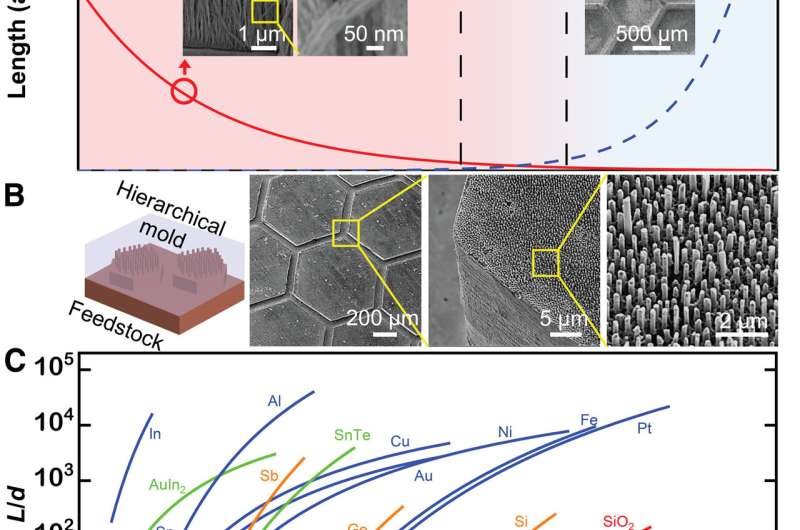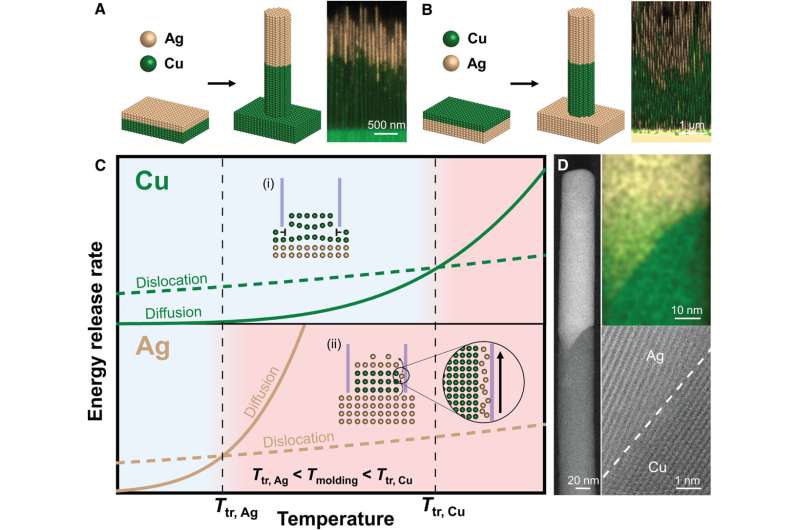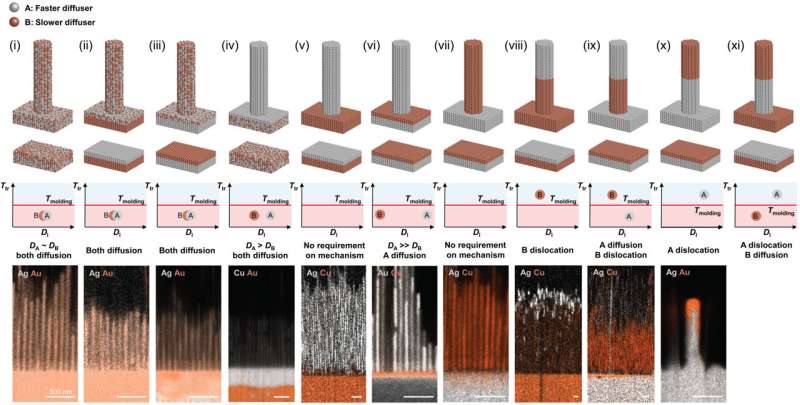Mechanism of thermomechanical nanomolding (TMNM). (A) TMNM uses temperature and mechanical pressure to mold feedstock material into nanomold arrays. (B) Discussed material transport mechanisms on this length scale result in different length scaling, L versus d. Bulk diffusion (Eq. 1) results in L(d) ∝ const, interface diffusion gives L(d)∝1d√ (Eq. 2), and, for a dislocation slip mechanism, L(d) ∝dx (x ∈ [1,2]) (Eq. 3). (C) L(d) scaling experiments reveal the temperature-dependent mechanism for TMNM of Ag. Interface diffusion dominates TMNM at high temperatures, T > 0.4 Tm, whereas dislocation slip takes over at low temperatures, T < 0.4 Tm. (D) To compare TMNM across different systems, we normalize the forming length L to L'=L/8pΩtkBT−−−−√. Absolute values of experimentally determined L from Au, Ag, and Cu suggest an interface diffusion mechanism. The superimposed lines represent the magnitude of normalized molding length for interface diffusion, (L′)2 = δDI/d and bulk diffusion, (L′)2~DL/4 (section S3). (E and F) Images of Ag nanowires corresponding to the data in (C). Credit: Science Advances, Doi: 10.1126/sciadv.abi4567
Advances in nanotechnology require the development of nanofabrication methods for a variety of available materials, elements, and parameters. Existing methods do not possess specific characteristics and general methods of versatile nanofabrication remain elusive. In a new report now published in Science Advances, Naijia Liu, Guannan Liu and a team of scientists in mechanical engineering and materials science at the Yale University and the University of Connecticut in the U.S. described the underlying mechanisms of thermomechanical nanomolding to reveal a highly versatile nanofabrication approach. Based on the results, they could regulate, combine and predict the ability to develop general materials with material combinations and length scales. The mechanistic origins of thermomechanical nanomolding and their temperature-dependent transition provided a process to combine many materials in nanostructures and provide any material in moldable shapes at the nanoscale.
Thermomechanical nanomolding (TMNM)
Researchers must advance the methods of nanofabrication to develop nanodevices in response to the ever-increasing demands of applications at the nanoscale. It is therefore ideal to facilitate a fabrication method that can develop a range of materials with diverse features including shapes, lengths and a regulated elemental nano-architecture. The demands can span across diverse fields ranging from optics, electronics, life science and energy harvesting to quantum materials. While researchers have already developed many methods to realize such applications, most nanofabrication methods are relatively limited. In order to produce a versatile nanofabrication method that provides a process to regulate the size, shape, chemistry and elemental distribution within the nanowire, researchers must obtain deeper insights to the underlying mechanisms of fabrication, length regulation, the composition of elements and their transport. Thermomechanical nanomolding (TMNM) is a recent advance realized in metals, which can be explored for nanofabrication. In this work, Liu et al. identified the size and temperature-dependent underlying mechanisms of TMNM to offer a variety of materials and material combinations, as well as elemental distributions across a range of materials.
Materials and length scales that can be realized through TMNM. (A) Estimated molding length as a function of molding dimension at intermediate molding temperature shows the transition of the dominating molding mechanism in TMNM from interface diffusion controlled to dislocation slip. TMNM can fabricate a large range of length scales from 5 nm (Ag, L ~ 8 μm) controlled by diffusion to millimeters (Au, ~1 mm) by dislocation. (B) Au sample hierarchical structures composing of a hexagonal micropattern (1 mm, through dislocation slip) combined with nanowire arrays (250 nm, through interface diffusion). (C) Calculated molding aspect ratio (L/d) according to Eq. 2 for interface diffusion as a function of temperature for representative materials from metals (blue), nonmetals (orange), oxides/ceramics (red), and ordered phases (green) including various functional materials. Credit: Science Advances, Doi: 10.1126/sciadv.abi4567
Understanding the underlying mechanisms of TMNM (thermomechanical nanomolding)
To develop nanostructures, Liu et al. drove the feedstock (raw) material under an applied pressure and elevated temperature in a nanopatterned hard mold. They estimated bulk diffusion, interface diffusion and dislocation slip to regulate this process as underlying mechanisms. To identify the fundamental mechanisms of TMNM, the scientists analyzed the molding length vs. molding conditions. The scaling for bulk and interface diffusion is based on Fick's Law. They used scaling experiments to determine the mechanisms of TMNM for a given set of processing parameters to reveal diffusion-dominated TMNM at high homologous temperatures. Comparatively, at low homologous temperatures, the mechanism of dislocation slip dominated the TMNM. The experimental findings showed that either diffusion or dislocation mechanism could be better described via a superposition of both mechanisms. The transitions in the mechanisms controlling TMNM did not only occur with temperature alone, but also with molding size. Using the method, the team developed ultrathin nanowires down to 5 nm in diameter via diffusion. However, it was challenging to develop molds with smaller diameter. To form wires of a smaller diameter, they used a dislocation slip-dominated TMNM. In this way, the researchers could use a one-step molding process to develop both micro- and nano- features based on dislocation slip-dominated mechanisms and an interface-diffusion mechanism, respectively. The method also allows versatility across a range of materials including pure metals, non-metal elements, oxides and ceramics.
TMNM using multilayer feedstock. (A and B) Heterostructure nanowires are fabricated when using layers as feedstock. Here, we use Ag/Cu layers as example. The fabricated heterostructures are with distinct regions of essentially pure Ag and Cu. When using Ag/Cu-layered structure with Ag layer facing the mold and Cu away from the mold, the order in the heterostructure nanowires is identical to the order in the feedstock (A). When using a Cu/Ag-layered structure with Cu layer facing the mold and Ag away from the mold, however, the order in the heterostructure nanowires (Ag─Cu) has reversed over that of the feedstock Cu/Ag (B). (C) Temperature-dependent molding mechanisms for Ag and Cu where the transition temperature (Ttr) is shown, which indicates the transition from dislocation slip–dominated to an interface diffusion–dominated molding mechanism. In the case of (A) and (B), the higher interface diffusivity in Ag results in lower Ttr than Cu. A molding temperature of Ttr, Ag < Tmolding < Ttr, Cu results in the formation of Cu nanowire by dislocation slip, where the Ag atoms surpass on the mold/nanowire interface of the Cu region through the interface diffusion process. (D) Scanning transmission electron microscopy characterization reveals an atomically sharp Ag─Cu interface that forms during this process. Credit: Science Advances, Doi: 10.1126/sciadv.abi4567
Development of heterostructures
The experimental conditions also allowed the team to regulate the elemental distributions and form a range of heterostructure nanowires, with particular interest for many applications, including nanodevices with operating principles relying on functional interfaces, photodetectors, field-effect transistors and light-emitting diodes. To show the development of heterostructure nanowires using TMNM, the team incorporated copper (Cu) and silver (Ag) layers and considered different orders of these layers in the raw material. They showed how diffusion-dominated TMNM formed nanowires of single-crystal structures, while nanowires formed via dislocation slip were polycrystalline, or maintained a 'bamboo' grain structure. Liu et al. further studied the Cu-Ag heterostructures and the Ag/Cu interface using transmission electron microscopy. The results showed a sharp and clean interface between silver and copper.
TMNM as a toolbox to control elemental distributions. The range of elemental distributions that can be achieved through TMNM using alloys or layered structure as feedstock. By using feedstock with different material combinations and considering their relative diffusivities and controlling molding mechanisms (molding above or below Ttr) of each component, we can control the chemistry and structure of the nanowires. In the 11 cases listed, homogeneous alloys and layered element feedstock are used. Their relative diffusivities and Ttr for the involved elements relative to the molding temperature define the elemental distribution within the nanowire. This can be a homogeneous alloy (i to iii), single element (iv to vii), or heterostructure nanowires (viii to xi). The bottom row shows example systems for the specific cases. Credit: Science Advances, Doi: 10.1126/sciadv.abi4567
Outlook
In this way, Naijia Liu and colleagues showed the possibility to regulate elemental distribution on the nanowire by designing the processing and material properties using the TMNM (thermomechanical nanomolding) process to achieve versatile nanostructures. An aspect of the experiment included the raw material, which could be alloyed or made into layered structures. The team considered the relative diffusivity of the elements to define their presence in the raw material. Using the technique, Liu et al. could develop a homogenous alloy nanowire. They highlighted how the underlying mechanisms of TMNM were based on temperature and size-dependent transitions. For example, with high temperature and small size variations, the method depended on diffusion at the interface of the material and mold. At larger size and low-temperature, the mechanism of dislocation slip dominated the outcome. The described technique of thermomechanical nanomolding is a powerful paradigm shift to implement nano-applications with desired features at the nanoscale.
More information: Naijia Liu et al, Unleashing nanofabrication through thermomechanical nanomolding, Science Advances (2021). DOI: 10.1126/sciadv.abi4567
Ruoxue Yan et al, Nanowire photonics, Nature Photonics (2009). DOI: 10.1038/nphoton.2009.184
Journal information: Science Advances , Nature Photonics
© 2021 Science X Network
![Mechanism of thermomechanical nanomolding (TMNM). (A) TMNM uses temperature and mechanical pressure to mold feedstock material into nanomold arrays. (B) Discussed material transport mechanisms on this length scale result in different length scaling, L versus d. Bulk diffusion (Eq. 1) results in L(d) ∝ const, interface diffusion gives L(d)∝1d√ (Eq. 2), and, for a dislocation slip mechanism, L(d) ∝dx (x ∈ [1,2]) (Eq. 3). (C) L(d) scaling experiments reveal the temperature-dependent mechanism for TMNM of Ag. Interface diffusion dominates TMNM at high temperatures, T > 0.4 Tm, whereas dislocation slip takes over at low temperatures, T < 0.4 Tm. (D) To compare TMNM across different systems, we normalize the forming length L to L'=L/8pΩtkBT−−−−√. Absolute values of experimentally determined L from Au, Ag, and Cu suggest an interface diffusion mechanism. The superimposed lines represent the magnitude of normalized molding length for interface diffusion, (L′)2 = δDI/d and bulk diffusion, (L′)2~DL/4 (section S3). (E and F) Images of Ag nanowires corresponding to the data in (C). Credit: Science Advances, Doi: 10.1126/sciadv.abi4567 Nanofabrication using thermomechanical nanomolding](https://scx1.b-cdn.net/csz/news/800a/2021/nanofabrication-using.jpg)


























